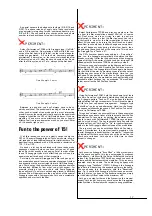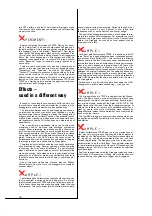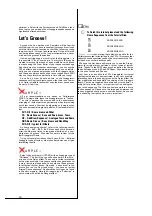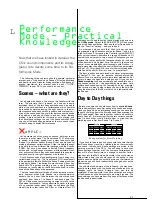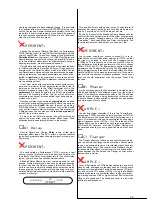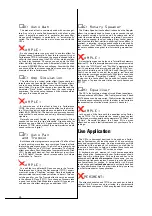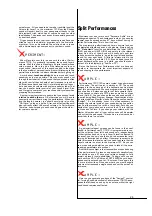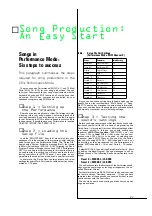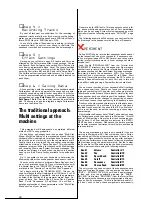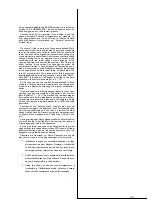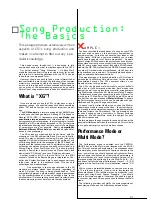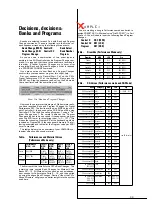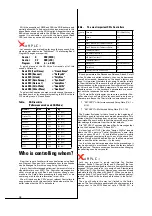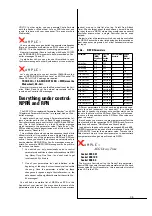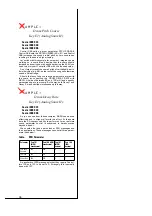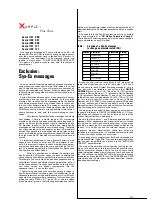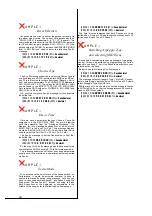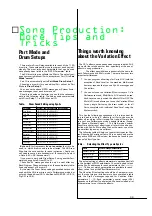
24
❯
(D) Auto Wah
The wah-wah effect is commonly used with various gui-
tars. As a rule, it is controlled dynamically with a foot rocker
pedal. It actually consists of a particular low-pass filter
whose cutoff frequency is periodically, i.e. “automatically”
varied. The Auto Wah can be put to many uses with the
CS1x.
A M P L E :
As a keyboard player you may wish to use this effect for
Clavinet sound for example. To hear this for yourself, try out
Performance TP106. In this case the sound is shaped further
still with the dynamic use of the CS1x‘s Filter, which explains
its lively play response. Of course you can apply the Wah
effect similarly to guitar sounds. Alternatively it can be used
to create X-PERIMENTal sound collages. Consider the Wah
as a second filter that is even capable of resonance. A good
example of this is Performance TP107.
❯
(E) Amp Simulation
This effect too is a typical guitar effect. It essentially imi-
tates the sound of an amplifier combo. The CS1x even allows
you to choose between different amp characteristics (Tran-
sistor/Valve). On top of this there‘s a low-pass filter and the
parameter “Drive” which controls how the input stage is
overdriven. The entire setup requires a little practice which
will pay off in the end however.
A M P L E :
A common use of this effect is found in Performance
TP108. You may not even perceive the effect on the first lis-
ten. This will quickly change when you disable the Variation
effect (VARI SEND=On). The basic sound now sounds much
more synthetic and carries and entirely different frequency
signature.
Naturally you aren‘t limited to string instruments. Other
sounds too can use this type ‘effectively’. Organ sounds for
instance can use a little dirt. A good example for this is Per-
formance TP109, which without the amp simulation would
sound rather too ‘digital’.
❯
(F) Auto Pan
and Tremolo
Both these effect programs are very similar. The Pan effect
is really nothing more than two combined Tremolo effects
that work against each other. The Auto Pan is primarily set
with the “Direction” and “LFO Freq” parameters. The Tremolo
effect even offers Pitch Modulation (compare this with Pitch
LFO – Analogue Workshop). First and foremost you will use
the “AM Depth” function which is responsible for Volume
modulation, i.e. Tremolo.
A M P L E :
You will find two different E-Piano sounds in the Tutorial
Performance bank. Using the first example (TP110), experi-
ment with various “Direction” settings. Here the developers
demonstrated their meticulous attention to detail. This can
only be good for you. The Tremolo effect is very pronounced
in the second E-Piano (TP111). For a change of scenery take
a good look at the Pitch Modulation as well. Of course you
can also use this effect simply as an additional LFO.
❯
(G) Rotary Speaker
The Rotary Speaker (Leslie effect) is based on the Doppler
effect. It is primarily used to liven up organ sounds through
the periodic varying of pitch as well as volume and tonal
colour that arise when a loudspeaker is rotated. Common are
two rotation speeds: the slow setting (Slow Leslie) gives a
kind of cathedral effect, similar to a floating Chorus effect. In
contrast, a vibrating, spinning soundscape is produced by
fast rotation (Fast Leslie). The increase/decrease between
these two speeds are a great tool for creating musical ten-
sion.
A M P L E :
A slow Leslie organ can be found in Tutorial Bank memory
location 112. As this example demonstrates, a medium value
for both the “LFO Depth” and “Dry/Wet” parameters fares
well. You determine the rotary speed with the “LFO Fq” func-
tion, which initially is set to 0,63Hz. Knob3 (Assign1=Vari-
Contrl) can be used to control the speed in real-time and
helps to play your organ authentically. With this in mind, take
a look at section “Controlling Correctly”. It goes without
saying that the Leslie effect can be used for sounds other
than organs. To prove the point, listen to a synth bass sound
(TP113).
❯
(H) Equaliser
The CS1x finally offers a choice of two different equalisers,
a three band mono EQ (Bass, Mid, Treble) as well as a 2 band
EQ. Their uses can be very varied. The first variant lends itself
to drastic sound reshaping, whilst the latter is well suited to
the accentuation of various levels (drum kit, bass etc.).
A M P L E :
Let‘s spend a little time with the equaliser using Perfor-
mance TP114. Try to eliminate the sound‘s bass content
(L.Gain) and work especially with parameters “M.Width” and
“M.Gain”. Be careful however: the 3 band EQ is a mono
effect, and as such it finally disables any of your Layers’ Pan
settings.
Live Application
The CS1x is downright destined to be used as a Perfor-
mance Synthesizer, not least because of it‘s eye-catching
looks and very portable design. As a live musician you will be
confronted with a unique set of problems, so we‘d like to
show you a few tricks to help you achieve those tasks and
keep you in control of your CS1x when on stage.
A keyboard sound‘s moment of truth comes especially
when playing live. Fundamentally, your Performances should
meet two main criteria here. For one the sound has to be
endowed with plenty of harmonics. If necessary, you can
boost certain frequency regions. Secondly you should mostly
use fast attacks for sounds. A harmonically rich E-piano
sound with a gentle attack phase would not really be suited
for live performance. Here are a few tricks to help you set up
your Performances for live applications:
PERIMENT:
The attack phase of sound TP115, as you can hear, is hardly
optimal. This E-piano sound is missing the characteristic
bell-like attack component. We have prepared this hammer








